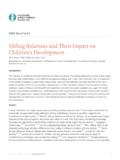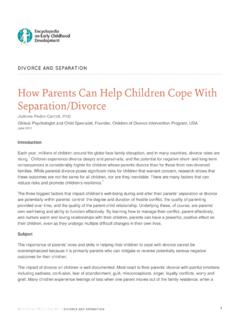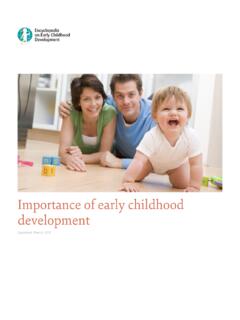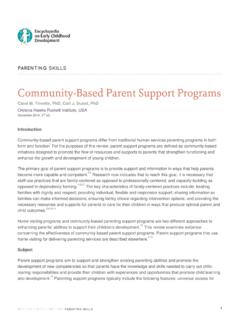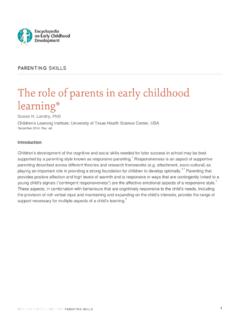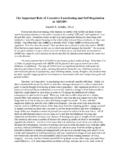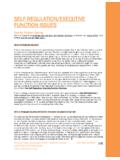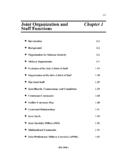Transcription of Executive functions - Encyclopedia on Early …
1 Executive functionsUpdated: January 2013 Topic Editor :J. Bruce Morton, PhD, University of Western Ontario, CanadaTable of contentsSynthesis 4 Brain Development and Executive Functioning 6 KATIE KNAPP, MSC, J. BRUCE MORTON, PHD, JANUARY 2013 Executive Functioning During Infancy and Childhood 12 YUKO MUNAKATA, PHD, LAURA MICHAELSON, BA, JANE BARKER, MPA, NICOLAS CHEVALIER, PHD, JANUARY 2013 Executive Function and Emotional Development 17M. ROSARIO RUEDA, PHD, PEDRO M. PAZ-ALONSO, PHD, JANUARY 2013 The Relation between Executive Functioning and Social Cognition 22 JEANNETTE BENSON, MA, MARK A. SABBAGH, PHD, JANUARY 2013 Protective Role of Executive Function Skills in High-Risk Environments 27 AMANDA J. WENZEL, BA, MEGAN R. GUNNAR, PHD, APRIL 2013 Socioeconomic Status and the Development of Executive Function 32 CAYCE J. HOOK, BA, GWENDOLYN M. LAWSON, BA, MARTHA J. FARAH, PHD, JANUARY 2013 Executive functions in the Classroom 37 CLANCY BLAIR, PHD, JANUARY 2013 Reflections on the Development of Executive Function: Commentary on Knapp and Morton, Munakata et al.
2 , Rueda and Paz-Alonso, Benson and Sabbagh, Hook et al., and Blair 42 PHILIP DAVID ZELAZO, PHD, JANUARY 2013 Cognitive Control and Self-Regulation in Young Children: Ways to Improve Them and Why [Slideshow] 47 ADELE DIAMOND, PHD, FRSC, JANUARY 2013 2013-2017 CEECD / SKC-ECD | Executive FUNCTIONS2222222222222222222222222222222 2222222222222222 Topic funded by 2013-2017 CEECD / SKC-ECD | Executive FUNCTIONS3333333333333333333333333333333 3333333333333333 SynthesisHow important is it? Executive functions are the cognitive abilities needed to control and regulate our thoughts, emotions and actions. A distinction is sometimes made between the cool component of Executive functions which strictly involves cognitive skills ( , the ability to do mental arithmetic), and the hot component, which reflects the ability to regulate emotions ( , being able to control anger). Executive functions can be divided into three broad categories of skills: Executive function abilities are critically important for development as illustrated by the fact that Early differences in Executive functions longitudinally predict important developmental outcomes, including academic achievement, health behaviours and social adjustment.
3 What do we know? Executive functions take time to develop to their full potential, and this is partly explained by the slow maturation of prefrontal cortex. Changes in Executive functions are apparent when children become able to remind themselves what the important goals are ( , finish one s homework rather than watch television). Improvements in Executive functions are also seen when children develop the ability to analyze their environment to decide what is the appropriate plan of action ( , studying tonight is crucial for success in tomorrow s exam). Underdeveloped Executive functions may explain why young children often appear hard-headed when refusing to follow logical instructions such as putting on a hat in the winter. Children from poor economic background are particularly at risk for experiencing Executive function the long maturation process of Executive function skills, children are acutely sensitive to Early experiences that can either hinder or boost their abilities.
4 Stress, for instance, can be so damaging to a young child s Executive functions that it can lead to a misdiagnosis of ADHD. On the other hand, enhancing experiences, such as a positive parent-child relationship, can protect children against the negative effect of stressful circumstances, such as living in poor economic conditions, and consequently improve Executive functioning. Children of responsive parents who use gentle rather than harsh discipline and who are supportive Self-control: The ability to resist doing something tempting in order to do the proper thing. This ability helps children pay attention, act less impulsively and stay focused on their memory: The ability to keep information in mind where it can be manipulated. This skill is necessary to perform cognitive tasks such as relate topics to one another, mental calculation, and decide what needs to get done in order of flexibility: This involves creative thinking and flexible adjustments to changing requests.
5 This ability assists children in using their imagination and creativity to solve problems. 2013-2017 CEECD / SKC-ECD | Executive FUNCTIONS4444444444444444444444444444444 4444444444444444of their child s autonomy also tend to have better Executive function Executive functioning is linked to several positive outcomes such as competency in the social, emotional and academic domains. In fact, they predict Early school success better than intelligence, Early numeracy and literacy. Executive function skills appear to enable children to navigate their constantly changing environment, which may be especially key for children developing in high-risk environments. Executive function efficiency predicts health, economic prosperity and few criminal acts in later life. Specific components of Executive functions are also responsible for children s ability to understand other people s minds. For instance, response conflict- Executive functioning (RC-EF) is strongly predictive of children s false belief understanding, the notion that others can have beliefs about the world that are different than one s own, which is a required skill for successful social there are several benefits to strong Executive function abilities, poor Executive functioning is characteristic of a number of disorders such as ADHD, behaviour problems, learning difficulties, autism and depression.
6 Early problems with Executive functions are also likely to persist throughout childhood and adolescence. What can be done?There are several benefits to helping preschool children improve their Executive function skills. Intervention programs focusing on Executive function training are efficient at enhancing children s school success and socio-emotional skills, and can lead to changes in brain circuitry. Early intervention may also attenuate the rate and the difficulties associated with disorders such as ADHD and behaviour problems. Executive function training is inexpensive and can be implemented in the regular classroom with children as young as 4 or 5 years of age. Modifications to existing Early childhood curricula should include enjoyable and challenging activities that focus on self-regulation. Yoga, music, aerobics, dancing, meditation, story-telling, martial arts are all examples of activities that can help improve core Executive function abilities.
7 In the classroom, children should engage in more active learning and small-group activities, and spend less time in large group activities. Children with better Executive functions require less negative interventions from teachers, which helps create a stress-free environment that further nurtures the development of Executive functions . Young children should also be encouraged to participate in elaborate forms of play, such as social pretend play where they learn to take on roles and adapt to ever-changing is also essential to understand that Executive function skills are acquired gradually through the years and that even a highly motivated child can struggle with instructions such as not eating a cookie before supper, or concentrating for a long period of time. 2013-2017 CEECD / SKC-ECD | Executive FUNCTIONS5555555555555555555555555555555 5555555555555555 Brain Development and Executive FunctioningKatie Knapp, MSc, J.
8 Bruce Morton, PhDWestern University, CanadaJanuary 2013 IntroductionExecutive functions are processes that support many everyday activities, including planning, flexible thinking, focused attention and behavioural inhibition, and show continued development into Early ,2 One important backdrop to the development of these psychological abilities is the structural and functional development of the ,4,5,6 Among the slowest developing brain regions is the prefrontal cortex, a large expanse of cortex located in the front half of the brain. Remarkably, this region of the brain continues to develop into the third decade of ,8 Brain imaging research9,10 and studies of patients with brain damage11,12,13 suggest that the prefrontal cortex is vital for controlling attention, thinking and behaviour, in part because it bridges perceptual, emotional and motor control centres located elsewhere in brain. The fact that prefrontal cortex is both slow to develop14,15 and important for Executive control has led to the suggestion that the development of Executive functioning is closely related to the maturation of the prefrontal ,17,18 One implication is that basic everyday challenges, such as not playing with a forbidden toy, will be difficult even for normally-developing that the prefrontal cortex is important for behavioural self-regulation and develops gradually may provide insight into why, for example, children have difficulty: (a) stopping one activity and switching to a new one; (b) planning ahead; (c) doing more than one thing at a time; (d) concentrating for long periods of time; and (e) foregoing immediate rewards.
9 Findings from developmental cognitive neuroscience research suggests these behaviours are a normal part of growing up and are rooted to some degree in how the brain works at this stage in life. ProblemsUnderstanding precisely how the development of the prefrontal cortex contributes to advances in Executive functioning is extremely challenging. First, Executive functions are difficult to precisely define and measure, in part because core concepts such as inhibition and cognitive flexibility actually do more to describe than explain behaviour. Second, it is unclear whether processes involved in regulating one kind of behaviour, such as language, are the same as those involved in regulating other kinds of behaviour, such as the emotions. Third, tasks that are appropriate for testing Executive functioning at one age will not typically be suitable for testing Executive functioning in older children. This makes it difficult to compare Executive functioning in children of 2013-2017 CEECD / SKC-ECD | Executive FUNCTIONS6666666666666666666666666666666 6666666666666666different ages.
10 Ultimately though, developmental cognitive neuroscientists are interested in linking age-related changes in Executive functioning with developmental changes in brain function. To achieve this, it is necessary to not only adequately define and measure Executive functioning, but to simultaneously collect a direct measure of brain function. One approach is functional magnetic resonance imaging (or fMRI), a safe and relatively non-invasive means of probing changes in brain activity that occur as people perform certain tasks. While viable and safe for use even with newborn infants,19,20 fMRI requires that participants remain very still for at least 5 to 10 minutes while the images are acquired. Abrupt movements 5 to 10 mm can render images noisy and virtually uninterpretable. Complicating matters further, if young children perform the prescribed tasks differently than older children, it becomes impossible to know whether age-related differences in patterns of brain activity relate solely to differences in the age of the participants or additionally to differences in the way younger and older children performed the tasks.
